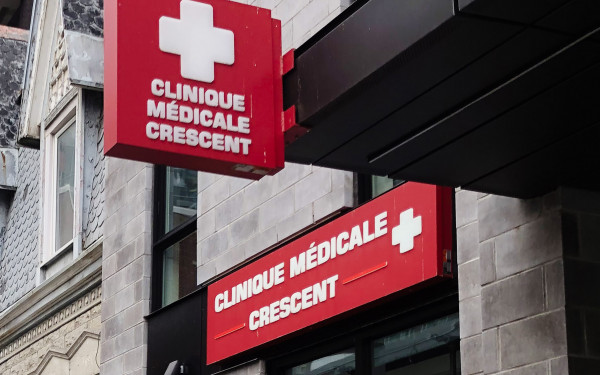Cuts to Health Services: Necessity or Ideology?
Provincial Health Reforms Will Unquestionably Reduce Quality of Healthcare
Racing to eliminate a budgetary deficit, Quebec’s Liberal government is moving forward with reforming the province’s healthcare services. Unfortunately, the system’s stakeholders—doctors, nurses, support staff and, most importantly, patients—will be the real losers of it all.
Bill 10, the first of the Quebec majority government’s healthcare reform bills, was passed on Feb. 6 with 62 yeas and 50 nays, despite opposition from Quebec’s College of Physicians and the federation representing specialized doctors. The bill will radically reorganize the province’s health and social services network, eliminating 18 regional health agencies and merging 182 establishments into 33 larger “Integrated Health and Social Services Centres” (CISSS).
Bill 20, meanwhile, seeks to “optimize the utilization of the medical and financial resources of the health system with a view to improving access to family medicine and specialized medicine,” according to the government. If passed in the National Assembly, the bill will impose a quota on family doctors, forcing them to take on a minimum of 1,000 patients or lose 30 per cent of their salaries.
There seems to be a consensus among the province’s two major political parties that government spending on healthcare is out of control. But many researchers disagree, pointing to data from Statistics Canada and the Canadian Institute for Health Information (CIHI) that paints a thoroughly different picture.
Quebec’s finance ministry says healthcare accounts for 42.6 per cent of government spending, while the CIHI says it accounts for 29 per cent. What’s more, the finance ministry’s data shows that the proportion going to healthcare is climbing dramatically, while the CIHI’s statistics suggest relative stability. Who should we believe?
In a report published last week by the Institut de recherche et d’informations socio-économiques (IRIS), Guillaume Hébert and Jennie-Laure Sully point out that the finance ministry uses the government’s program spending as the denominator, while the CIHI uses “consolidated expenses,” which takes into account the profits and losses of state-owned enterprises, various investment funds and interest payments on government debt. The latter is the figure recommended by Quebec’s auditor general, the report notes.
What’s more, the two researchers argue that calculating healthcare spending as a percentage of the province’s gross domestic product (GDP) is a better way of determining whether or not the province can afford to sustain its current healthcare services. Their report shows that public spending on healthcare oscillated between 6 and 8 per cent of GDP from 1981 until the late 2000s, climbing to a peak of 8.7 per cent in 2009 in the midst of an economic recession.
Since then, the ratio has been in decline.
What all of these numbers show is that there’s a degree of subjectivity in even supposedly “objective” statistics. Ultimately, cost-cutting measures in the healthcare sector are more a matter of ideology than a strict fiscal necessity. Even if healthcare spending actually were as unsustainable as the government suggests, consolidating healthcare institutions wouldn’t be a viable cost-saving measure. Quebec has been down the road of centralization before; and it wasn’t a particularly successful experiment.
Another IRIS report, titled “La gouvernance en santé au Québec” and published last February, details the province’s various attempts at reforming its healthcare system since the 1970s. Beginning in 2000, the report notes, the government has merged healthcare institutions, allowed doctors to incorporate themselves and implemented “patient-based funding” so that how much a hospital receives from the government is directly related to how many medical interventions its employees perform, as opposed to the quality of their interactions with patients.
The end result of those private sector-inspired reforms was to foster competition between hospitals and increase administrative costs. All of the additional paperwork required to keep track of what types of treatments were provided to patients meant the number of office workers employed in the health sector increased by 4 per cent, according to the report.
The government has also been slowly reducing local control over healthcare. In 2011, the Liberals changed the composition of health institutions’ governing boards with Bill 127, decreasing the number of spots on the board reserved for users to two from four and the number reserved for personnel to four from six. Meanwhile, the number of “independent” board members—businesspeople who are supposedly objective—was increased from two to six, the IRIS report notes.
“The government has also been slowly reducing local control over healthcare. In 2011, the Liberals changed the composition of health institutions’ governing boards with Bill 127, decreasing the number of spots on the board reserved for users to two from four and the number reserved for personnel to four from six.”
Now, Bill 10 takes it all a step further. The 182 governing boards of the province’s medical establishments will be dissolved, replaced by larger geographic authorities appointed by Quebec’s health minister. Institutions ranging from rehabilitation centres to old-age residences, from youth services centres to hospitals, will be lumped together for administrative purposes as a single public institution.
Once the bill has been fully implemented, the opportunities for citizen engagement will be even fewer, as the bill provides for only one representative of the institutions’ users on the new governing boards.
In an opinions piece published in the Montreal Gazette, Brian Gore, a family physician in Westmount, wrote that a considerable amount of expertise will be lost through the reforms. The new regional structures “will most certainly struggle to retain the level of competency acquired locally,” he noted.
It’s highly improbable that the regional institutions created by the bill will be better at responsibly allocating resources than local boards and senior administrators that have an understanding of local needs.
Bill 20 completes the entire process of dehumanizing the system that began with the passage of Bill 10. It reduces family medicine to a simple numbers game, encouraging doctors to prioritize quantity over quality of medical care.
Not every patient is the same; some require more attention from their doctors than others. Medical lawyer Jean-Pierre Ménard rightly suggested in a news conference at the start of the month that imposing a quota would only encourage medical professionals to take on patients with clean bills of health, leaving those with the greatest need even worse off.
In their report, Hébert and Sully point out that countries like Denmark, the United Kingdom, Brazil and Sweden have fostered greater accountability and a better allocation of resources by decentralizing and democratizing public services.
They describe a number of ways that citizen participation can be increased: input on institutional budgets, the election of institutions’ directors and senior heath administrators, citizens’ forums that would make recommendations to legislators, etc. Such a system would be far more accountable to stakeholders.
Improving the province’s healthcare system requires that we allow for more citizen participation in the decision-making process, not less.
Bills 10 and 20 present easy solutions to complex problems, and while they may help the government skim off some savings, patients will be left wanting with a system even less responsive to their needs.


_600_832_s.png)




